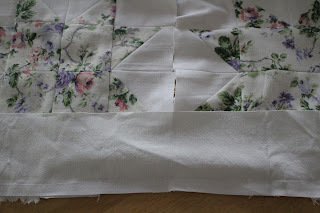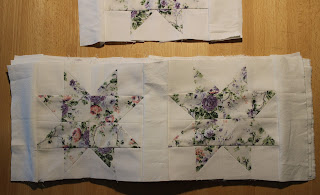I still have not finished my
StarQuilt blanket so you still need to wait for the tutorial part3. I do have all my needed
Stars but they are still waiting for me in a tidy pile to be put up all together. Well, I do have a good excuse you for sure can accept. It is the heat weave which crashed at
SeaLapland. It has been far to hot to do anything but swim and lay in my hammock. By the arctic circle it is rare to wake up on several mornings with the temperature +20 Celsius degrees in the shadow! Not to mention how high (+24) it rises during the day. Not to mention my sunny terrace and its +40 degrees! No,I am not complaining... just enjoying. :)
So, for all dog lovers and owners I decided to blog a bit about dog training. You know
Nuka arrived last December. She was just about 10 months old. She had some problems with
the water. Especially when it all started
to melt. She had
her lesson and stopped to play fool with this dangerous element.
But she must get familiar with the water. She is going to be a hunting dog. Ability to understand this element, swim in it and accept the wet water feeling not to mention about getting familiar with its influences and impacts can save her life in the wilderness. That is the main reason for her summer education with the water. Swimming makes good also for the muscles and joints so it is useful exercising format also for the dogs.
All my dogs have been good swimmers. Even the rescue dogs I've got after their puppy years. Not to mention about the dogs I've been looking after during their owners' holidays despite the owners told their dog hate to swim.
Granny didn't like to dive. She didn't love the water. It made her to be worried. She'd rather be elsewhere. Because of her traumas her education took few years but she did learn to trust us despite she didn't trust in the water; never. I don't know what had happen to her but I for sure can only image.
But how I make the dogs to swim? I don't do the things you see to be done, hear to be told to do or guided to do.
I NEVER throw them into the water from wharf, platform, shore, rock or anything. NEVER.
I NEVER carry them in my arms into the water and release in the depths they must swim back to the shore. NEVER.
I NEVER pull or push them into the water. Not into the smallest pond, ditch or brook where would be only half inch of water. NEVER.
I simply NEVER do anything to feel they are forced and demanded. I neither regulate their access into or by the water; meaning also that water bowl by which my kids or animals would make a huge mess. NEVER.
My dogs need to be able to swim. If your dog needs that skill too, start immediately. When the dog is still a tiny puppy it is easier because its own will is still smaller than yours. Being a puppy is a false excuse to avoid swimming education.
Instead of forcing I start with these lesson immediately when the dog arrives:
Free access to the water. ALWAYS. No matter how wet, messy or dirty it would get.
Daily walks mean also walking in the pouring rain and thunder storms. ALWAYS. Bad weather is not excuse. It is a good moment to teach the dog how the water feels and what it causes. If the dog doesn't want to go out in the rain, then I gently force it outside. The dog forgets soon its unwillingness for the wet walk when it notices everything smells and seems different when it is wet. Old bath towel can dry up a big dog after the walk. Just remember to brush by it also the armpits and stomach. Especially the hind legs and each paw to avoid mess inside the house. The dog will soon learn to accept this drying.
When you start with deeper and bigger water remember:
Keep the dog in the leash. ALWAYS. It is then under your control. Rather use harness if the dog fears. Feeling something powerful around the neck may cause more fear despite it would have got used to it in the normal daily use.
Going into the water must be ALWAYS dogs own will. Simply ALWAYS. You can cheat as much as you desire but not force. As long as the dog thinks it is its own choice how deep it gets or how long it stays in everything will be fine. Go somewhere where the dogs are allowed (in Finland it means where their access is not limited) and the water doesn't get too deep too fast. If the dog doesn't want to go deeper or stay longer cheat by walking in the water along the shore direction. There you can slowly go deeper inch my inch.
ALWAYS keep the dog busy. Play, give treats, support etc. Don't leave it there with its own mind and fears. Playing in the water must feel natural. Don't let it fill its head with stubborn thinking or being afraid of.
So far Nuka has learnt to breath through her nostrils instead of mouth when carrying her VeryImportantBone. She has also learnt when not to breath at all. Because she now dares to put her nose into the water we have moved on to the next level.
She has just started to learn to dive. Well, she can decide somewhere in the future will she dive or not. Or does she need to dive or not at all. But she needs to learn to pick up things from the water. The things that don't float. Because of the hunting and surviving in the wilderness.
This task asks a lot of courage and character from the dog. But greater issue is the bond between you two. How great is the trust. Picking up items like this pic shows must ALWAYS be dogs own will.
In this case Nuka had found a piece of wood from the shore. She lost it because it didn't float so it was an excellent moment to teach her this. I just took the wood into the lower water than she lost the wood. It was then her own will, did she really want the wood or not. She decided she wanted it. We did this approx 5 times and then she was allowed to carry her treasure to home.
Notice that I didn't touch Nuka at all when learning this. Not even a single hair of her. I neither pulled the wood under the surface if she was holding it. I just showed her that the wood really was in the water and pointed the exact location of it by my hands. In teaching this you need to be extremely fair and remember not to break the trust. Start with easy task and stay on easy level for a long time.





















































